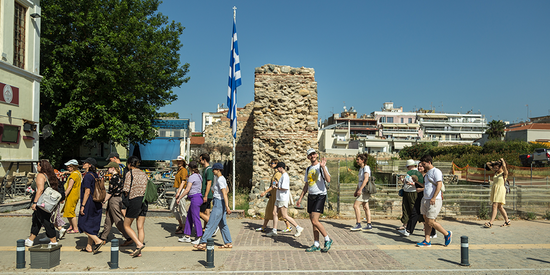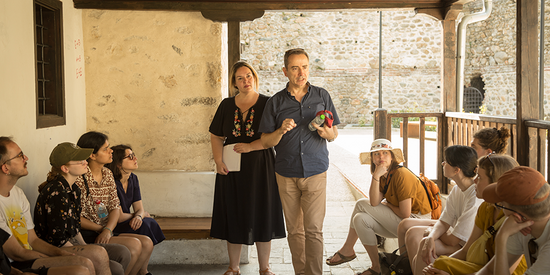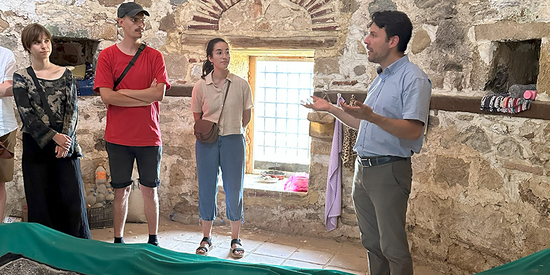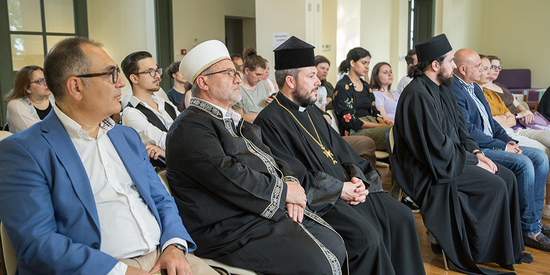Thessaloniki-Saloniki-Selanik: Northern Greece between Empire and Nation-States
In the spring semester of 2024, the students from the University of Basel went on a study trip to Greece. The excursion, led by Prof. Olena Palko and Julia Elena Grieder, was organised in partnership with the Aristotle University in Thessaloniki, and was financially supported by the European University Alliance EPICUR (European Partnership for an Innovative Campus Unifying Regions). This trip was a concluding part of the Seminar “After Empires: Imperial Legacies in Eastern and South-Eastern Europe" offered by Prof. Olena Palko. During the course, the students had the opportunity to learn about the Greek-Turkic forced population exchange of 1923, the legacy of which was thematised during the excursion. As a consequence of the exchange around 1’300’000 Greek-Orthodox people left the newly founded Turkish state, while around 400’000 Muslims had to move from Greece to Türkiye. Besides this specific research interest, the student group also hoped to learn more about the history of Greece in the 19th and early 20th century more generally. For this excursion, the students were split into six groups, each of which chose one particular topic to explore and develop during our stay in Northern Greece.
On 4 June, the students rose with the sun to set off to Greece. Already at six o’clock in the morning, the group took the train to Zurich and from there went by plane to Thessaloniki, while others had already left two days earlier, on Sunday, to get to Northern Greece by train, ferry, and bus. All twenty participants had safely reached the hostel by early afternoon. The same day, the group met on the hilly slopes of the city, at the highest point of the old Byzantine wall of Thessaloniki. Our guide Panagiota Triantafyllopoulou led us through the city’s history, from the Byzantine past to the Greek present. On our way downhill, we passed by some of the buildings erected by the municipality to accommodate the refugees from Asia Minor and the southern Black Sea coast, who flooded the city after 1923. Those houses, although small, were quite a luxury at the time when most refugees coming to Thessaloniki had no other choice but to sleep wherever they could: parks, ruins or former military barracks abandoned by the Allies outside the city walls. Panagiota then guided us to the monument in honour of Eleftherios Venizelos, Greek Prime Minister, and the main architect of the 1923 population exchange. Our tour ended at the heart of the city, on Aristoteles Square, where we could witness the jubilant crowds of Thessaloniki residents taking photos with the national cup the local football club had just won.
The next day started with an academic visit to the Historical Archive of Refugee Hellenism in the suburban area of Komotini, built almost entirely after 1923 to accommodate the refugees. This municipally funded archive focuses on collecting, transcribing, and researching (oral) testimonies of people involved and affected by the population exchange. The collection numbers thousands of memoirs and oral testimonies from the challenging times following the exchange. The highlight of the visit was the lecture by the leading archivist and scientific researcher Eleni Ioannidou, detailing the horrific experiences of the refugees upon their arrival by sea often with nothing more than the clothes they wore. The concluding discussion highlighted the distinctions between the population exchange, and the Turkish atrocities against Greeks in other areas, touching upon highly political and emotionally charged questions of whether the Ottoman state's policies and actions towards the Pontic Greeks in the aftermath of the First World War could be classified as genocide.
In the archive, we also had the pleasure of meeting and discussing our ongoing projects with the students from the Aristotle University of Thessaloniki and the University of Macedonia. They were accompanied by Prof. Maria Kavala (Aristotle University) and Prof. Iannis Carras (University of Macedonia), both of whom have academic and personal interests in the history and legacy of the population exchange. After the visit, the students spent an afternoon in mixed groups to continue working on their small research projects. Many helpful recommendations and ideas were received from the local students, which helped stir our research in the right direction.
In the afternoon, we visited the Museum of Macedonian Struggle where we were welcomed by Dr. Konstantinos S. Papanikolaou. He guided us through the museum’s exhibition, located in the very same building, in which the Greek consulate was situated during the late Ottoman period. The exhibition is dedicated to the guerilla war between mainly Bulgarian and Greek fighters over the sovereignty of the region before the First Balkan War, the conflict which is today referred to as the Macedonian Struggle. Although this conflict is not deeply embedded in the collective memory today, one of its fighters, Pavlos Melas is considered a national hero, a person whose sacrifice, supposedly made the Greeks ‘conscious’ of what they were, and for what they fought.
Our day continued at the Monti Lazariston festival, where some participants were able to clear their minds with musical tunes by the famous Greek musician Konstantinos Vita.
On Thursday morning, we met again with our guide Panagiota to continue exploring the city’s Jewish past. We were surprised to learn that in the late Ottoman period and up to the population exchange, the majority of Thessaloniki’s inhabitants were Jews. The Jews were so central to the city’s identity, that Thessaloniki was nick-named the Jerusalem of the Balkans. The Jewish Museum of Thessaloniki is a testament to the rich Jewish heritage of the city, largely invisible outside of the museum’s walls. Only glimpses remained, whereby silences become even more striking. Close to the Museum, the Holocaust memorial commemorates the plight of the local Jews under the Bulgarian occupation and the deportation of 50'000-60'000 local Jews to Auschwitz-Birkenau. Equally, the large Jewish cemetery with around 300’000-500’000 graves, once located just outside of the city walls, was dismantled during the occupation. Some of its gravestones were subsequently used as pavement stones, that have not been removed, or properly treated even today. The site of the Jewish cemetery was later used for the construction of the Aristotle University campus.
In the afternoon we visited the Aristotle University, where we met Prof. Maria Kavala, Prof. Evgenia Grammatikopoulou and their students. One of the topics for discussion was the novel “Farewell Anatolia” by Dido Sotiriou, which we all were able to read before the excursion. The novel, which covers the period of the First World War, the Asia Minor campaign, the Smyrna fire as well as the population exchange, was very well received. During the discussion, it was interesting to learn that the history of the exchange and the Asia Minor campaign, as taught in primary and secondary schools, was very one-sided, focusing on the victimisation of the Greeks. The book helped us understand that such a one-sided narrative may indeed be too simplistic.
Evgenia used the discussion of the book as a bridge to introduce us to the literary representations of the 1923 events. She focused on Greek authors from Asia Minor and their place in the Greek national canon. The ensuing discussion touched upon the question of whether novels can help us understand historical events, especially when written by eyewitnesses. Although no conclusions were reached, we enjoyed the experience of exchanging opinions with students and professors from different universities working on diverse topics. Those discussions continued in the evening during our joint dinner in a traditional Greek restaurant.
Our academic exchange with the Aristotle University continued on Friday morning as we listened to Maria Kavala’s insightful lecture on “The Contribution of Refugees from Asia Minor to the Modernization of the New Greek State.” Maria provocatively claimed that the arrival of refugees helped to modernise Greece, as the Greek state tried to use the skills and knowledge of the incoming refugees, on the one hand, and was forced to become very progressive to respond to their countless economic and social needs, on the other.
The lecture was followed by our group presentations outlining the progress we had made so far concerning our small research projects. Once again Maria Kavala was very generous with her time and expertise on how to improve our research. The topics that interested the students were wide-ranging. One group focused on the local and collective memory culture of the population exchange, while another looked at the legacy of the exchange in the field of culture, especially in music. An interesting approach was taken by the group that engaged with the gendered experience of the exchange, focusing on the experience of women and children. This was followed by an analysis of how the events of 1923 affected the cityscape of Thessaloniki and then a discussion of the co-existence and intercultural exchange of Northern Greece, especially Western Thrace past and present. The discussion of the Jewish identity, and their shift from a majority to an insignificant minority, was the focus of the last research project.
In the afternoon we visited the Atatürk Museum which is located on the territory of the Turkish Consulate in Thessaloniki. The museum building was the house in which Mustafa Kemal Atatürk was born, a major discovery for us since few of us knew, that the ‘Father of the Turks’ was born outside of modern Türkiye. We then proceeded to the Thessaloniki War Museum, where we were given a guided tour around the exhibition that consisted of artefacts and documents from the history of modern Greece. The tour commenced with the Greek Revolution of 1821 and concluded with a room that discussed the violent practices of the era of the military dictatorship of 1967-1974.
The second part of our excursion started on Saturday, 8 June, and took us east from Thessaloniki to Kavala and the Thracian cities of Xanthi and Komotini. Western Thrace was exempt from the population exchange of 1923, and to this day has retained its national and religious diversity, with a significant Muslim population. It is by far the most multicultural area of today’s Greece and to some extent serves as a window into the area’s vibrant past before ethnic homogeneity and nation-states became the norm in Europe.
Our program in the region of Macedonia and Thrace was curated by Prof. Vasilis Ritzaleos from the Department of Language, Literature & Culture of the Black Sea Countries of the Democritus University of Thrace, and Nikos Kosmidis, the Manager of Communications and Public Relations of the Foundation for Thracian Art and Tradition. Thanks to Vasilis and Nikos, we were able to examine the multifaceted history of the region and learn about the religious coexistence and the legacy of the Lausanne Treaty.
Our first stop in Kavala was the Mohammed Ali Research Centre, formerly home of Mehmet Ali, who is widely known today as the founder of the modern Egyptian state. From there, we proceeded to an old mosque guided by Sappho Ageloudi-Zarkada, a retired architect. Sappho familiarised us with the history of Kavala, and its significance for the region. We were also able to enjoy cold drinks in a café nearby, situated in the old 19th-century house, restored by Sappho using only the materials available during its original construction. We exchanged our first impressions of the city in a small tavern nearby, which served as the place from where people could escape during the Bulgarian occupation of Kavala during the Second World War.
The next day we visited the Tobacco Museum, passing by dozens of abandoned Tobacco warehouses, which had served as shelter for many of the refugees coming to Kavala after 1923. At the museum, the director Cleopatra Halvatzoglou introduced us to the traditional tobacco industry and its significance for the region. For decades, before the industry’s final decline in the 1960s, Kavala served as one of the trading hubs for Basmas tobacco that was shipped worldwide. One of its most productive periods, as Cleopatra told us, was linked to the 1923 population exchange, as refugees provided much-needed labour force for the industry.
We continued with a walk through Kavala, guided by Vasilis, Cleopatra, and Nikos who were eager to tell us about various aspects of the area’s history. It was during one of those stops that Vasilis, who specialises in the history of Jews in the region, mentioned the once bustling Jewish community of Kavala, all of whom were deported and killed in Treblinka. The monument, the erection of which Vasilis had facilitated, became a bone of contention with the municipality and has been vandalised several times since.
The highlight of our stay in Kavala was the visit to the Museum of Refugee Hellenism where the President of the Association Sofia Tsigou, and the museum curators Manolis Zaharopoulos and Eleni Ioannidou shared family testimonies and firsthand experiences of refugees that came to the region. Despite temperatures reaching 35 degrees Celsius and above, they seemed to never get tired of sharing stories they had collected over many years, as well as their own family histories. It was there that many of us realised what the decision, once made by the Greek and Turkish rulers with international support, really meant for hundreds of thousands of people affected. We were then taken to the museum’s exhibition, which comprised artefacts belonging to numerous refugee families that came to Greece from Asia Minor. The guides turned each object into a vessel of memories, uncovering the stories behind each of them, sometimes heart-wrenching but often filled with hope and fond memories.
Our last encounter with the city was the castle of Kavala which had served as a guard’s post overlooking not only the cities but further to the east and west along the shoreline. We enjoyed the cool evening sea breeze and the magnificent views from the top of the hill.
Our visit continued with a stop in Xanthi, where we were first invited to a talk by the director of the Foundation for Thracian Art and Culture Dr. Andreas Matzakos. He introduced us to the history of the Pomaks, an ethnic Muslim group that lives in the Rodopi Mountains, which form the border between Greece and Bulgaria. Dr Matzakos later invited us to see the collection of traditional costumes of the Cultural Association of Pomaks in Xanthi, located in one of the former tobacco warehouses. This was followed by a brief overview of the foundation’s projects and activities presented by Nikos Kosmidis. We continued our explorations of Xanthi with Nikos, who walked us through non-touristic parts of the town of Xanthi, uncovering numerous social problems in the region, many of which originated in the 1920s. On our way, a local historian and activist Giannis Gogos took over as our guide. Among many stories Giannis told us, one stood out: during the Ottoman period, Christian churches were prohibited from having bell towers. To circumvent this, one church planted a tree right next to the building and, once it grew toll enough, in an act of defiance, hung the bell in its crown.
With Giannis, we visited the Folk & Historical Museum of Xanthi, which is located in the house once belonging to a family of rich tobacco trader. From there, we continued to the Holocaust Memorial, erected with the support of the local cultural foundation PAKETHRA. We were privileged to meet Prof. Vasilis Aivaliotis, a member of the board, who introduced the monument and outlined the significance of the Jewish history of the town. Nikos then walked us to an abandoned tobacco warehouse, where the entire Jewish population of Xanthi was concentrated before being deported to Treblinka during the Shoah. Here, yet another horrifying silence about the Jewish past came to the fore. The building is surrounded by numerous schools and educational institutions, yet the fate of the Jewish community has never been thematised. Moreover, numerous attempts to hang a memorial plaque or gain access to the privately owned building to see any possible remains from the time of the concentration of the Jewish population there were refused.
On our way to Komotini, we made a short detour to visit a unique place of worship that is used by both Muslims and Christians. The Kutuklu Baba burial monument is situated in an enclosed complex amidst vast grain fields. Entering the monument there is a room decorated with Orthodox icons. The adjoining room contains a covered shrine which serves as a place of pilgrimage for the Alevite Bektasi movement. Nikos introduced us to the place and explained how it was possible that one building came to be used by members of both faiths – it was once again due to refugees who used this shrine for their own worship at a time when little was available to them.
In the evening Prof. Palko delivered a lecture at the municipal library of Komotini. Apart from the students from the Democritus University of Thrace and the University of Basel, the lecture was attended by the deputy mayor of Komotini, the Honorary Consul of Armenia in Thessaloniki, and the representatives of the different religious communities of Komotini. The lecture, entitled “Greeks in Ukraine during the early Soviet period,” was based on the current SNF-funded research conducted by Olena at the University of Basel. The many questions that followed, as well as features on the front pages of local newspapers, showed the interest the talk and Ukraine-related topics had sparked.
Following this, His Eminence, the Mufti of Komotini Dr. Tzihat Khalil, welcomed us to the Yeni Mosque, the oldest mosque in Komotini. He shared some insights into the history of the building as well as the significance of its various components. Dr. Khalil then invited us to take part in the evening prayer. This was a unique opportunity to witness religious practices firsthand and continue sharing our thoughts and questions with the Mufti.
The following morning, a local archaeologist and museologist Naya Dalakoura, took us for a cultural walk through the historical centre of Komotini. We walked the main street, where there once stood a mosque, an orthodox church, as well as a Jewish synagogue in close proximity. We entered the still-standing Metropolitan Church of the Assumption of the Virgin, where the priest, together with our guide Nikos chanted a short prayer for the victims of the Russian war against Ukraine.
Our next stop was the Armenian Orthodox Church of Gregory the Illuminator. There, following a brief introduction to the history of the church and the Armenian presence in Komotini, a short service for those affected by the war, led by Father Daniel Kaloghlian took place. In the adjoining Armenian community centre, we were welcomed with a snack and drinks and then had the possibility to hear the story of the Armenian diaspora from the President of the Armenian Community of Komotini, Stepan Mateosian. He explained to us that the Armenian presence in the region, and Greece more generally, is intricately connected to the population exchange of 1923. After the Armenian Genocide of 1915-1916, some Armenians fled to Asia Minor, the territory around Smyrna that the Greek army would occupy after the First World War. Following the Greek defeat, many Armenians left with the retreating army and arrived in Greece where, under pressure from the League of Nations, they were allowed to stay. Thus, the Armenian community of Komotini came into existence.
Just a few houses further on, we had the privilege to meet the Metropolitan of Maroneia and Komotini, His Eminence Panteleimon. His Eminence, like the Mufti and Father Kaloghlian before him, emphasized the importance of having good relations with the other religious groups in the region. He highlighted that these relations, especially in everyday life, are smooth and that there are numerous joint initiatives between the different religious groups.
We left the Metropolitan’s office with local sweets in hand, to walk to the old train station where we had lunch and exchanged our views, opinions, and experiences of the recent days. With a full stomach, we dispersed to prepare for the last academic engagement of the trip. The lecture by Dr. Vasiliki Filiou from the Demokrit University of Thrace focussed on the settlement of the refugees in the region of Komotini, and the reaction of the local population on their arrival. Vasilis Ritzaleos, who helped us organise this part of the excursion, had one last surprise for us: local drinks and snacks, encouraging us to share what we learned during the trip, our experiences and what we will take home from the excursion.
The next morning, we returned to Thessaloniki, where we had our last guided tour through the Byzantine Museum with a local historian Constantinos Sfika. He had the challenging task of motivating us on a hot afternoon after we had already experienced ten days packed with experiences and information. Our tired faces did not discourage him; with great enthusiasm, Constantinos managed to do just that. In the end, thanks to his interactive style, he succeeded in teaching us why a Basilica is called like that and how old amphoras could either serve as a coffin or as a sewer pipe.
On Thursday, 13 June, we met for the last time to say goodbye to each other and to wish a safe journey back (or relaxing holidays for those who did not go straight back to Basel). Tired, but filled with an abundance of new experiences, a deepened understanding of the region’s history, and new friendships we left Thessaloniki and parted ways.
As we found out in the days following our return to Switzerland, our visit to Greece and especially to Western Thrace made headlines in the Greek newspapers thanks to Nikos and Vasilis. At first, it spread in the local media but then was picked up by the national news agency (Athens News Agency–Macedonian Press Agency). Their article was then reposted by several major news sites, including the largest an doldest newspaper of the Greek diaspora in the USA.
Text by Micha Steiner, Photos by Nikos Kosmidis and Oksana Hela






















